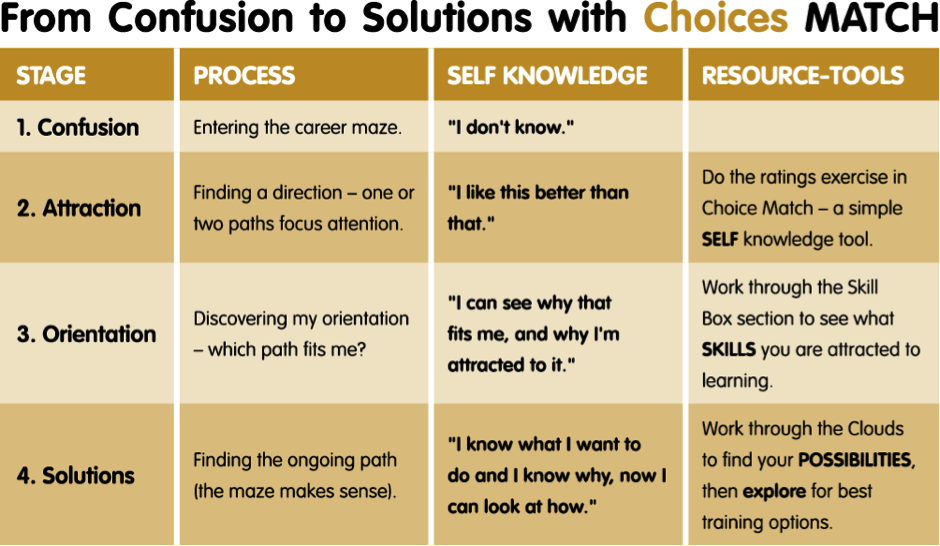This tool is based on 25 years’ experience of my face to face and distance work with clients of all ages and stages, with a particular emphasis on addressing the decision making challenges for young people.

Choices Match is based on this model I have developed from the concept of vocational orientation.
The Self Directed search theory of John Holland underpins the SELF focus of this tool; I have developed a self-ratings tool based on Holland’s type theory to encourage self- awareness, and to introduce the idea of vocational orientation, (the area/work/ environment I fit best, and will thrive in). There is significant evidence of the usefulness of this typology in career choices and subject decision-making for young people, as well as for choices over the lifespan.
• Self-assessment is the sustainable skill for career decision-making and is used throughout this tool. We need to grow this ability in young people and encourage this in all clients so that they develop an ability to make good choices over their career lifetimes. The bonus of a self-assessment tool is all the choices are the users own – there is no surprise ‘job’ or industry that emerges to confuse and often disappoint a user on completion.
• The skills focus in this tool is not the old style instruction of identify the skills you have,’ it is ‘identify the skills you want to learn, use, and/or get very very good at.’
Boxes of skills are provided in matching colours to the self types identified; giving the signal and the understanding that these are most likely to be the ones you are going to be good at.
Identifying the skills of interest as well as the industries that attract a young person gives significant clues to the client and to the advisor about where to start exploration.
• Holland’s concept of vocational orientation provides a very wide foundation for exploration and assists young people to look in the right direction. As the user works through the program they should be encouraged to narrow down choices to get to the most desired. This is the best starting place for exploration. When the user explores related training, choices will broaden again as the user learns all the possibilities that training might lead to, within a work area. Even though we have many job title changes over a lifetime, they tend to be in similar areas of vocational orientation, utilising similar sets of skills at different levels.
• To explore is critical – it is in this process that a person might see exactly what appeals, whether in a training option or in future work possibilities. This tool is designed to encourage this final task, hopefully after users have narrowed down the huge world of choices and gained enthusiasm and momentum from their results.
“Jana was buzzing when she left you, and she never looked back. It wasn’t just finding the right path – and now five years later she is very successful in it – it transformed her –she was just so motivated and interested in her study.’ (Parent conversation, 2016.)
“…..you had a consultation in Hawkes Bay with my then 22 year old son who had floundered around after leaving school. I am happy to report that since then he has gone from strength to strength and has at last found real engagement in his studies. In 2012 he had a really successful year working towards a science degree at Auckland University, taking papers in Maths, physics, geology and computer science. He successfully continued these studies in 2013. “(Parent email, 2015)
These comments are here to illustrate just one thing: the powerful energy that occurs when young people can see their future possibility and know they are on the right path for them.
Self- Directed Search type tools have always been a starting place in my work, because they help people see for themselves where they fit, and they are the reason for many happy and motivated clients.
Holland’s concept of vocational orientation is the following:
The vocational orientation that most attracts us is likely to be the area that
It works as a package! Sometimes people are very strongly oriented towards one area, others are mixed. That is more challenging but this is a tool that accommodates that.
Notes for usage of Choice Match with clients are available to career professionals.